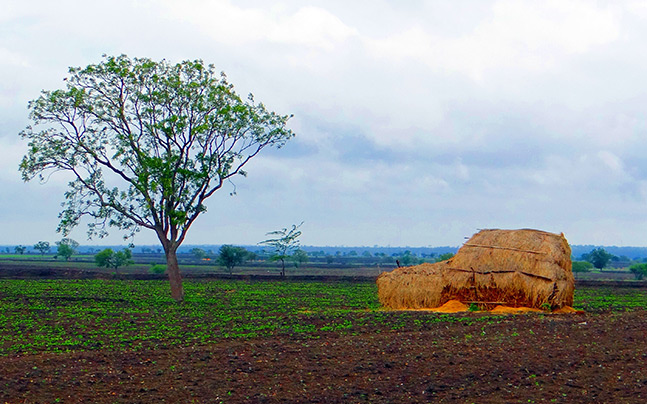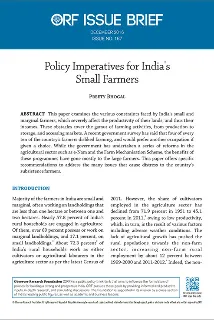Introduction

Majority of the farmers in India are small and marginal, often working on landholdings that are less than one hectare or between one and two hectares. Nearly 57.8 percent of India’s rural households are engaged in agriculture. Of them, over 69 percent possess or work on marginal landholdings, and 17.1 percent, on small landholdings. [i] About 72.3 percent [ii] of India’s rural households work as either cultivators or agricultural labourers in the agriculture sector as per the latest Census of 2011. However, the share of cultivators employed in the agriculture sector has declined from 71.9 percent in 1951 to 45.1 percent in 2011, [iii] owing to low productivity, which, in turn, is the result of various factors including adverse weather conditions. The lack of agricultural growth has pushed the rural populations towards the non-farm sector, increasing non-farm rural employment by about 12 percent between 1999-2000 and 2011-2012. [iv] Indeed, the non-farm sector has emerged as a residual sector for people who find agriculture to be risky and lacking in remuneration.
Despite a large number of subsistence farmers engaged in food production, little has been done by the state to improve their living conditions. According to the government’s Situation Assessment Survey of Farmers conducted in 2003, four of every ten farmers disliked farming and would prefer another occupation if given a choice. Of these, 27 percent believed that farming is not profitable and eight percent felt that it was risky. [v] While these results may be unexpected, they highlight the degree of dissatisfaction among the country’s farmers, stemming from genuine issues that need to be addressed urgently.
Small farmers: Constraints and government response
Small farmers in India face various obstacles related to procuring technological, financial and institutional support. These issues include: limited access to formal credit and insurance; lack of capacity-building programmes to train them in modern farm equipment and practices; inadequate water supply for irrigation; little or no scope for crop diversification; and absence of marketing facilities. Most of these challenges are common to both small and large farmers, but the degree of access to various agricultural inputs often varies, and large farmers find some advantage. For example, it is easier for large farmers to access public (canal) and private (tube-wells) sources of irrigation as compared to small farmers, who are mostly dependent on groundwater that is already depleted, to begin with. This disparity in access to information and inputs makes the small and marginal farmers more vulnerable to productivity risks.
The following section discusses the various constraints faced by India’s small farmers.
Markets for selling produce — To improve access to markets for small farmers, the government has recently launched a new programme, called e-Nam. This is a virtual common market for trading agricultural commodities, which is expected to remove information asymmetry between buyers and sellers, and thereby make the entire trading process more transparent. The success of such systems would depend on the level of farmers’ education and openness to learn alternative modes of interaction with buyers. A report by the National Commission for Enterprises in the Unorganized Sector showed that literacy rate among small and marginal farmers was 55 percent and 48 percent, respectively, [vi] which is lower than the national average literacy rate of 72.98 percent — 67.6 percent in rural areas and 84.1 percent in urban areas. [vii] It would be highly difficult, therefore, for the rural populations to capitalise on the government’s digital initiatives in the agriculture sector.
Access to water, fertilisers, pesticides, seeds and other inputs— In water-stressed regions in India — among them, Maharashtra, Punjab, Haryana, Karnataka – access to water is a major problem. Farmers with large plots of 10 hectares and above and who have access to modern machines and pumps consume large amounts of water, leaving little for the small farmers who are unable to install the same pumps. They are left to rely largely on rains for growing crops, or else, to buy water from nearby tube-wells.
For fertilisers and pesticides, the continuously rising prices resulting from supply moderation restrict the access of small farmers to these basic inputs. For the past two years, for example, farmers in the Majuli district of Assam have had to develop an alternative method of pest control that involves eating the beetles that infest the crops grown in the area. [viii] Although farmers find this shift to more organic practices to be a positive development, it also serves to highlight the government’s failure to regulate the fertiliser market to provide easier access to subsistence farmers.
The limited availability of high-yielding varieties of seeds in India — a result of inadequate research inputs for developing new pest-resistant and high quality seeds — often hampers agricultural productivity.
Moreover, the cost of hybrid seed varieties is exorbitant for small farmers. [ix]
Access to credit and insurance facilities — Due to the low incomes earned by small and marginal farmers, despite higher output produced (nearly 51.2 percent to the total output of the country in 2002-03) [x] and complex operating procedures at formal lending institutions, these farmers are left to resort to informal channels of credit to finance their investment and consumption needs. In 2012 it was found that about 85 percent of marginal farmers were dependent on non-institutional credit markets such as village landlords, traders, friends and others, who charged 100 times the formal credit markets’ rate. [xi]The incidence of indebtedness was nearly 82 percent among small and marginal farmers in India in 2011-12, [xii] which analysts say was likely the most aggravating factor for widespread despair among farmers, leading even to suicides in various states.
The government has initiated several schemes like the Farm Mechanisation Scheme and the Price Support Scheme to provide easier and more reliable credit channels to the farmers. However, these programmes are often perceived to be working in the interest of the big landholders, while the small and marginal farmers continue to remain in distress. Further, the interest subvention subsidy under the Farm Mechanisation Scheme has been criticised for encouraging farmers to divert funds away from agriculture to more profitable options. [xiii]This scheme has been misused by large farmers, who lend money at high interest rates to small farmers who are outside the ambit of formal credit mechanisms.
Meanwhile, the Crop Insurance Scheme is a programme of which more than half of the farm households were unaware; 24 percent had no access to the facility. [xiv] The states with the largest number of households with no access to the facility included Jammu and Kashmir (72 percent), Punjab (67 percent), Haryana (42 percent), Bihar (49 percent), and Rajasthan (37 percent).
Limited scope for crop diversification — Small and marginal farmers in India own/practice farming on landholdings of less than two hectares, which are often fragmented, and only a few of these have access to adequate irrigation facilities. The constantly shrinking average size of these small landholdings has limited the scope for crop diversification. Moreover, the government initiatives focus mainly on rice and wheat production. This includes price guarantee for produce due to the provision of a minimum support price for the production of rice, wheat, coarse cereals and a few pulses. These initiatives are limited to only a few states. This discourages farmers, especially the small and marginal, to undertake production of commercial crops. Farmers become more risk-averse, thereby decreasing the possibility of undertaking crop diversification in the future. There are potential benefits of crop diversification, particularly in states that face adverse soil problems or are water-stressed. For instance, one acre of land under high-value crops can generate relatively more income than five acres planted to cereals. [xv] There is a need to put in place effective government mechanisms for training individuals who would encourage farmers to undertake commercial crop production along with food grains, keeping in mind the likely benefits of crop diversification.
There are potential benefits of crop diversification, particularly in states that face adverse soil problems or are water-stressed.
Absence of post-harvest infrastructure — Farmers incur frequent losses due to lack of adequate storage and warehousing facilities for their produce. This often leads them to sell their produce at a distressed price. This is a pan-India problem that affects all agricultural products. In early 2016, for instance, potato farmers in Odisha suffered huge losses as nearly 20 percent of their produce fell to waste due to the absence of cold-storage facilities. [xvi]Similarly, onion farmers in Maharashtra suffered huge losses as a 35-day strike at the Agriculture Produce Market Committee forced them to store produce at their own homes, resulting in huge amounts of spoilage. [xvii]
The government has taken some steps to address this problem. One such initiative is the elimination of service tax on all cold-storage facilities provided by the state-run National Centre for Cold Chain Development. A Krishi Kalyan Cess (@ 0.5 percent) has also been initiated on all taxable services to fund farm activities. While these are positive steps, a lot more needs to be done. The storage facilities in every state must be commensurate with the annual agricultural production in that state. Further, these facilities must be affordable to all farmers, especially the small and marginal.
Limited Capacity-building programmes/Extension services for Farmers — Small and marginal famers have limited access to technical advisers and modern technology, essential for improving output and productivity of various agricultural activities. The public sector extension services in India are provided through various mechanisms, such as Training and Visit System, Krishi Vigyan Kendras (KVKs) — a total of 645 KVKs in the country at present — and Agricultural Technology Management Agency initiated particularly for the rural districts.
However, public and private agencies in India have failed to ensure universal access to these services in the agriculture sector due to limited manpower. [xviii]In 2005, for instance, only 40 percent of the agricultural households in India had access to agricultural information from any of the available sources. Based on the disaggregation of information availability by farm sizes, only 38.2 percent of small farmers had access to information as against 53.6 percent of large farmers. [xix]The preferred sources of information for small farmers were other progressive farmers (16 percent); input dealers (12.6 percent); radio (12.4 percent); television (7.7 percent); newspapers (six percent); and extension workers (4.8 percent). [xx]The role of extension workers in disseminating information among large farmers is quite significant; 12.4 percent of large farmers received information via this source. Large variations in access to these services have added to the vulnerability of the subsistence farmers.
[P]ublic and private agencies in India have failed to ensure universal access to these services in the agriculture sector due to limited manpower.
Conclusion
India has no doubt emerged as a breadbasket for the world as its agricultural production and exports of cereal crops has increased manifold over the past decades. The post-Green Revolution era brought prosperity and higher incomes for farmers. However, these gains were not evenly spread among the farming households. The small and marginal, subsistence farmers, continue to struggle given the many constraints that they face. The results of the Situation Assessment Survey for Farmers (2003) has highlighted the farmers’ apathy towards their profession. Nearly 40 percent of rural subsistence farmer households disliked farming and preferred to be engaged in any other occupation; they also said they did not want their children to continue practicing agriculture on the family land.

While the government has taken steps to improve the plight of farmers, no specific attention has been paid to the problems faced by subsistence farmers. For one, they do not have access to inputs and extension services to improve the productivity of their lands. The marginal farmers also face difficulty in undertaking crop diversification due to the small size of their landholdings, affecting their profits and prospects for additional investments. The government must develop an inclusive extension system wherein small farmers are trained to undertake cultivation of cereals and commercial crops simultaneously on the same land. This move would not only increase farmers’ incomes, but also encourage the sustainable use of land and other inputs. Regions that are water-stressed could be used for cultivating crops that do not require large quantities of water, such as pulses and cotton. Water must also be made available in sufficient quantity to all farmers. For this, large farmers must be encouraged to use alternative sources of irrigation like drip and micro irrigation, and trained to conserve and recharge water sources so that they do not deprive the subsistence farmers of this scarce and valuable resource.
Farmers in India are also prone to climatic and weather fluctuations that have an adverse impact on their incomes. The situation is aggravated by the absence of proper infrastructure like storage facilities and warehouses, which affect the quality of the produce and, in turn, their prices. Plans to increase storage facilities must be executed at the earliest as this would insure farmers against losses arising from the absence of warehousing facilities.
Small and marginal farmers bear the brunt of high interest rates on loans as very few farmers have access to credit from formal financial institutions. The coverage of formal credit institutions must expand to include small farmers. For this, the government needs to build an agency that would connect small farmers in all states at all levels to the lending institutions. To plug leakages in the interest subvention scheme, direct transfer of income to banks must be widely implemented. This would further require integration of small farmers in the banking sector. It is noteworthy that as of 31 March 2014, nearly 101.09 million Kisan Credit Cards were issued to farmers in India. [xxi]
Agriculture is a state-subject in India and it is the responsibility of states to improve access to essential facilities for the farmers in their region. Several programmes in agriculture have been sponsored by the Central government to enhance the productivity of this sector but they have not succeeded much in terms of realisation of higher incomes for all farmers. It is important for the Central government to assume a supervisory role to ensure proper utilisation of funds provided to the state governments. Regular checks on the status and progress of different schemes must be undertaken in a timely manner. Effective implementation and execution of schemes is an imperative in order to address the long-standing concerns of the country’s subsistence farmers.
The views expressed above belong to the author(s). ORF research and analyses now available on Telegram! Click here to access our curated content — blogs, longforms and interviews.

 PDF Download
PDF Download





 PREV
PREV


